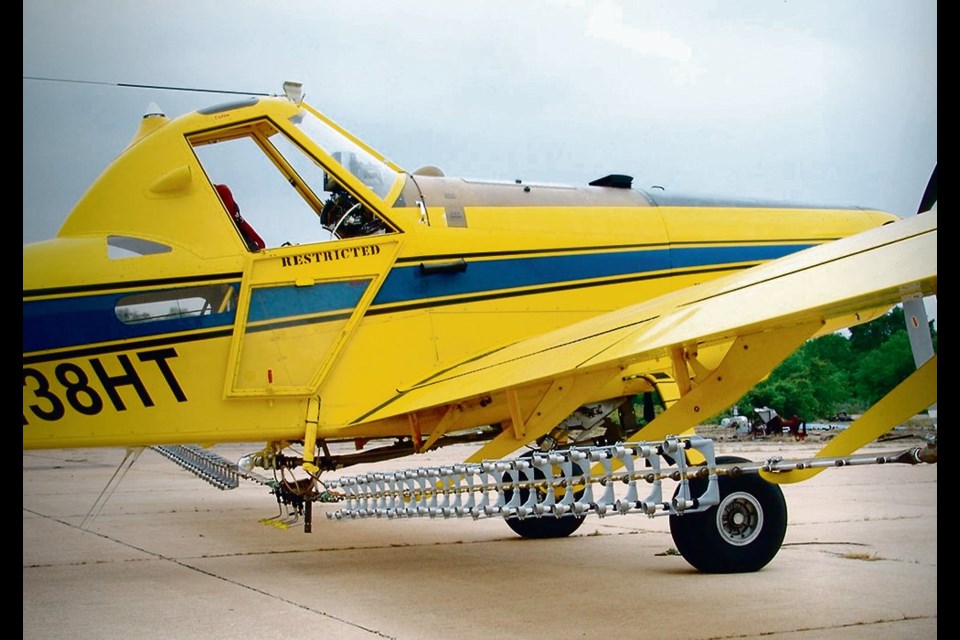The Weather Modification cloud seeding project is headed by engineer Dan Martin working out of the United States Department of Agriculture research unit at College Station, Texas.
USDA scientists determined that water can be coaxed out of clouds if the drops are activated by a small electrical charge. In the rain enhancement project, meteorologists identify which cloud formations have the best rain potential on any particular day. The spray plane is sent to those clouds.
In earlier work, Weather Mod induced rain by sending a plane into a water-laden cloud with one flare attached to trailing edge of each wing tip. The pair of flares were either silver iodine for the upper portion of the cloud where it’s colder, or calcium chloride for lower warmer parts of the cloud.
“That’s working really well. In west Texas we typically average 20 inches of rain per year. With Weather Mod, we’ve increased rainfall by 12 to 15 percent,” says Martin.
“That’s an extra two to three inches. It may not sound like much, but it makes a big difference to farmers and ranchers in the area. They’re growing forages, cotton, corn, soybeans and cattle of course. That additional rain is huge to them.”
Martin compares flares to the sparkplug in an engine. He says this small component makes a small spark in a small area, but that’s enough to get the whole mechanical process going. The flare may be small relative to the whole cloud formation, but it kick-starts a large movement of rain.
Particles of silver iodine or calcium chloride are called cloud condensation nuclei (CCN). They provide an anchor to which cloud moisture can attach. Once the first moisture attaches, the CCN grows slightly. That attracts another small bit of water. Now the CCN begins to snowball and grow as more moisture bits hop aboard. Finally it’s heavy enough that it falls out of the cloud in the form of rain. Really large droplets from taller clouds freeze and become hail.
When Martin began delving into the electric approach to cloud seeding, his new CCN became a small droplet of charged water. The flare system worked, but he wanted a better CCN.
“We charge the droplet because we know the cloud has it’s own charge. We give our droplets an opposite charge so water in the cloud is attracted and bonds to it. Our charged droplet grows until it’s heavy enough to fall to Earth as rain.”
Martin’s experience with charged droplets extends back many years to when he worked on the technology of charging pesticide droplets. He proved that aerial and ground applicators could increase the deposition of chemicals on the target crop using electricity.
“Then we realized this same technology could be used to enhance rainfall. We started with wind tunnel tests here in College Station and in Florida, giving us information we needed to take to the air. The results were outstanding. At that point we already had 20 years of data using flare technology, so our electric results had a good comparison.”
All clouds hold water, but some are better candidates than others for seeding. Not only does the electric system outperform the conventional flare system, it can also extract rain from clouds, which the flares cannot. Weather Mod continues making these comparisons by operating two aircraft simultaneously in the same cloud formations, one with flares and one with electricity.
“We’ve treated clouds that were dying, disappearing. Flares couldn’t save them. But we were able to revive them with our electric technology. Flares are US$80 each, so you really don’t want to waste a pair of them on a dying cloud. And you can’t turn them off if you realize the cloud won’t give water. They burn until they’re done.
“The environment is another factor. We’re not using chemicals of any kind and we’re not using flare material. All we’re doing is adding water to a cloud. Water may not be the best carrier of electricity, but it’s working very well, so we’re sticking with it for now.”
Martin says Weather Mod may also prevent hail or at least soften the impact of hail. Rain enhancement might turn golf-ball-sized hail into pea-sized hail, thus preventing a lot of crop damage.
“Look up at the very top of those tall clouds. That’s where you find the coldest temperatures. Rain drops up there turn to ice and come tumbling down as hail. Then, while they’re still light weight, they get carried back to the top by an updraft. They pick up more water and become heavier yet. They may go through this up/down cycle multiple times, after which they’re big and heavy and dangerous.
“If we start stealing this water early in the storm, it doesn’t have a chance to cycle up to the top and pick up more water. Early indications are that we’re creating more rain while at the same time decreasing the severity of the storms. We don’t have any data yet, but those are the early indications.”
The aerial electric system uses only microamps to put a static charge on the water droplets. The charging device itself is a cylindrical stainless steel electrode that surrounds the nozzle. As a droplet exits the nozzle, it shoots past the trailing edge of the electrode, which induces a charge. Water doesn’t actually touch the electrode. Now the charged droplet is free of the airplane and ready to start rounding up other droplets from the cloud.
Rain Enhancement uses an Air Tractor 402B. The cost of installing an electrostatic system on a spray plane is about US$40,000 including installation and pilot training. The sole supplier is Spectrum Electrostatic Sprayers. Their specialty is crop spraying equipment, but their electrostatic system works just as well for cloud seeding with some modifications.
Martin says, “Any ag spray plane can be outfitted with an electrostatic system. Any competent aerial applicator can be trained to make it rain.”




